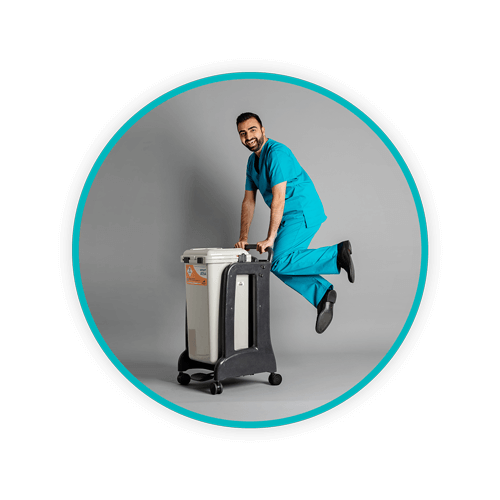There Is Only One Compliant Reusable Sharps Container in the UK. Here’s Why

When it comes to sharps waste disposal in the UK there are two major systems that NHS Trusts employ: single-use sharps containers and reusable sharps containers. While there are no requirements mandating the use of one system over the other, there are major safety, sustainability, and efficiency benefits to operating with a reusable system. However, until recently there had been no official standards or regulations governing the design and construction of reusable containers in the UK, meaning that it was possible for non-compliant devices to enter the market. That changed in 2019 with the introduction of BS EN ISO 23907-1 and BS EN ISO 23907-2, covering single-use and reusable containers, respectively.
 The new regulations were developed to ensure that a certain level of safety and quality were incorporated into sharps containers through the standardisation of rigorous requirements and test methods. Since the introduction of the new standards in 2019 (BS EN ISO 23907-2:2019), only one reusable container has proven to be fully compliant. You guessed it: Sharpsmart.
The new regulations were developed to ensure that a certain level of safety and quality were incorporated into sharps containers through the standardisation of rigorous requirements and test methods. Since the introduction of the new standards in 2019 (BS EN ISO 23907-2:2019), only one reusable container has proven to be fully compliant. You guessed it: Sharpsmart.
As healthcare facilities increasingly adopt reusable container systems, it’s important to not just understand the benefits of those systems, but the superior design requirements that make it a safer and more sustainable alternative to other sharps container solutions.
TOPICS WE WILL COVER:
1 / A Brief History of Sharps Container Standards in the UK
2 / Key Components of the Reusable Sharps Container Standard
3 / The Benefits of Adopting Reusable Sharps Containers
4 / Making Healthcare Safer with Sharpsmart
A Brief History of Sharps Container Standards in the UK
The first reusable sharps container system was introduced in the UK in 2002 as an alternative to traditional single-use containers. At the time, the relevant technical requirements and test methods in the UK were only applicable to single-use containers (BSI Standard 7320). 
Typically, reusable containers would require additional and more rigorous performance testing to prove that they would continue to meet all performance criteria throughout their full lifecycle, which can be upwards of 50 years. Because the UK lacked those additional standards, it became possible for lower-quality systems to enter the market that would otherwise be rejected under global testing standards.
To address this gap in standards, the British government, with support from manufacturers like Sharpsmart, moved to adopt international standards to help ensure global alignment of healthcare worker and patient safety. The British Standards Institute (BSI) accomplished this by adopting standards instituted by the International Organization for Standardisation (ISO).
First, in 2012, a new single-use container standard (EN ISO 23907-1) was adopted by BSI to supersede their existing standards. During the production of that standard, the ISO began working on a standard for reusable containers as well, which launched in 2019 as BS EN ISO 23907-2. (They also updated Part 1 in 2019.)
Critically, this new standard includes requirements for lifespan simulation, cleaning and decontamination, microbial validation, quality monitoring, and performance testing for reusable standards.
What this means is that reusable containers are benchmarked for a certain standard of cleanliness, safety, and quality so that they perform compliantly, ‘as designed’, after each use. Thus, the standards are a key reference point for NHS professionals concerned with the quality of their reusable sharps containers.
Key Components of the Reusable Sharps Container Standard
While there are many similarities between the single-use and reusable container standards, the key point of differentiation is enhanced testing requirements for reusable containers to ensure their quality over a long lifespan. Put simply, the new standards confirm the superior design quality of reusable containers by incorporating standards above and beyond those of single-use containers. 
As an example, while all containers must undergo testing for resistance to spillage by toppling, reusable containers also require the following procedures:
- Lifespan transport and processing simulation testing – procedures that the container must undergo prior to standard sharps testing to ensure transportation and processing standards (e.g., opening, decanting, decontamination, and closing)
- Cleaning and decontamination process overview – an outline of the stringent cleaning and validation processes required to render containers safe for reuse. While there are multiple cleaning methods, this standard stipulates that the process must be automated, validated, and continually monitored.
- Test procedures for microbial validation – this section outlines the requirements for validating the efficacy of the decontamination process and establishing validation parameters.
-
Post decontamination quality assurance monitoring – the process by which quality assurance standards are developed and implemented.
In addition to those supplementary standards and procedures, some testing requirements applicable to both single-use and reusable containers are enhanced for reusables. For instance, the minimum and average penetration force requirements for single-use containers are 16 Newtons and 18 Newtons, respectively (i.e., the force it would take for a sharp to puncture the container). By comparison, the minimum and average penetration for requirements for reusable containers are both 20 Newtons, meaning reusable containers must meet a higher standard than single-use containers.
The Benefits of Adopting Reusable Sharps Containers
Since their introduction to the UK market in 2002, the benefits of adopting reusable containers have been clear, and in the following two decades additional research and insights have only further highlighted those contrasts.
- Sharps Injury and Prevention – with safety-engineered features like a gravity balanced safety tray and leak-proof seals, reusable containers are proven to reduce incidences of sharps injuries. One study of 28 Ascension Health hospitals in the United States found that converting to Sharpsmart reduced after-procedure injuries by 30%, disposal-related injuries by 58%, and container associated injuries by 81%. In a UK-specific example, Winchester & Eastleigh Healthcare NHS Trust saw an 18% reduction in needlestick injuries after adopting Sharpsmart, including zero injuries in the first 12 months of introducing the system.
- Labour Reduction and Staff Efficiencies – when used correctly and optimised for a specific site, reusable containers can achieve significant labour reductions and staff efficiencies by reducing the total number of container exchanges for the total waste generated. In one instance, adopting a reusable system resulted in a 51% decrease in container exchanges. While that research was conducted in the US, the results are applicable on a global level.
- Greenhouse Gas Emission Reduction – Reducing greenhouse gases (GHG) is a critical component of the Route to Net Zero, and reusable containers are an effective sustainable purchasing strategy. Resent research found that hospital trusts that switch to reusable containers reduce the carbon footprint of their waste streams by 83.9%. There are also significant waste reductions and landfill diversions through the elimination of single-use cardboard and plastic. When Rotherham NHS Foundation Trust Hospital introduced Sharpsmart, they reduced 13 tons of plastic and 1.3 tons of cardboard from their annual landfill waste volumes.
While this just scratches the surface when it comes to the advantages of reusable containers, the benefits are clear. In the past, it might be understandable to forgo those benefits out of concern for the ambiguity of standards in the UK. Now, with the introduction of BS EN ISO 23907-2:2019, those concerns are allayed.
For the first time, there are clear, actionable standards and parameters to benchmark the performance of reusable containers, allowing healthcare workers the peace of mind they deserve.
Making Healthcare Safer with Sharpsmart 
Sharpsmart is driven by the goal of making healthcare safer, challenging long-instilled practices with innovative products and services designed to enhance risk prevention. As an advocate for safer hospital solutions, we strive to partner together with healthcare providers and industry stakeholders to push the global standards for safety.
It’s no surprise then that Sharpsmart is currently the only provider of reusable sharps containment systems in the UK to meet BS EN ISO 23907-2. While other container manufacturers may appear to provide reusable containers and promote their benefits, those containers are likely not able to meet the stringent requirements that are critical to ensuring the safety, sustainability, and longevity of reusable containers.
So, if you are interested in making healthcare safer, improving efficiency, and supporting sustainable initiatives – all while remaining compliant! – there is only one choice. Call us today to learn more.
